How to Freeze Asparagus
on Jul 13, 2022, Updated Mar 07, 2025
This post may contain affiliate links. Please read our disclosure policy.
Here's the best way to freeze fresh asparagus so you can enjoy those tender crisp stalks later in the year.

Fresh, local asparagus is only available for a short time each year. If you’re lucky enough to find an abundance of fresh asparagus, you’ll want to consider freezing it so that you can enjoy those crisp, tender stalks later in the year.
In seasonal climes, the peak season for asparagus is spring. Exactly when and for how long fresh asparagus is available depends on where you live. Look for fresh asparagus in the produce section of your local market (often, it will be labeled as local asparagus) and your favorite farmers market. Or maybe you’re a gardener, and when asparagus season hits, you have more than you need. Asparagus is usually available in U.S. supermarkets year-round, but the asparagus you see in the late summer and the cold months probably comes from far, far away.
By signing up, you agree to our Privacy Policy.
By freezing your fresh asparagus, you can grill asparagus, steam asparagus, roast asparagus, and find all sorts of ways to cook with asparagus all year long!
What's In This Post?
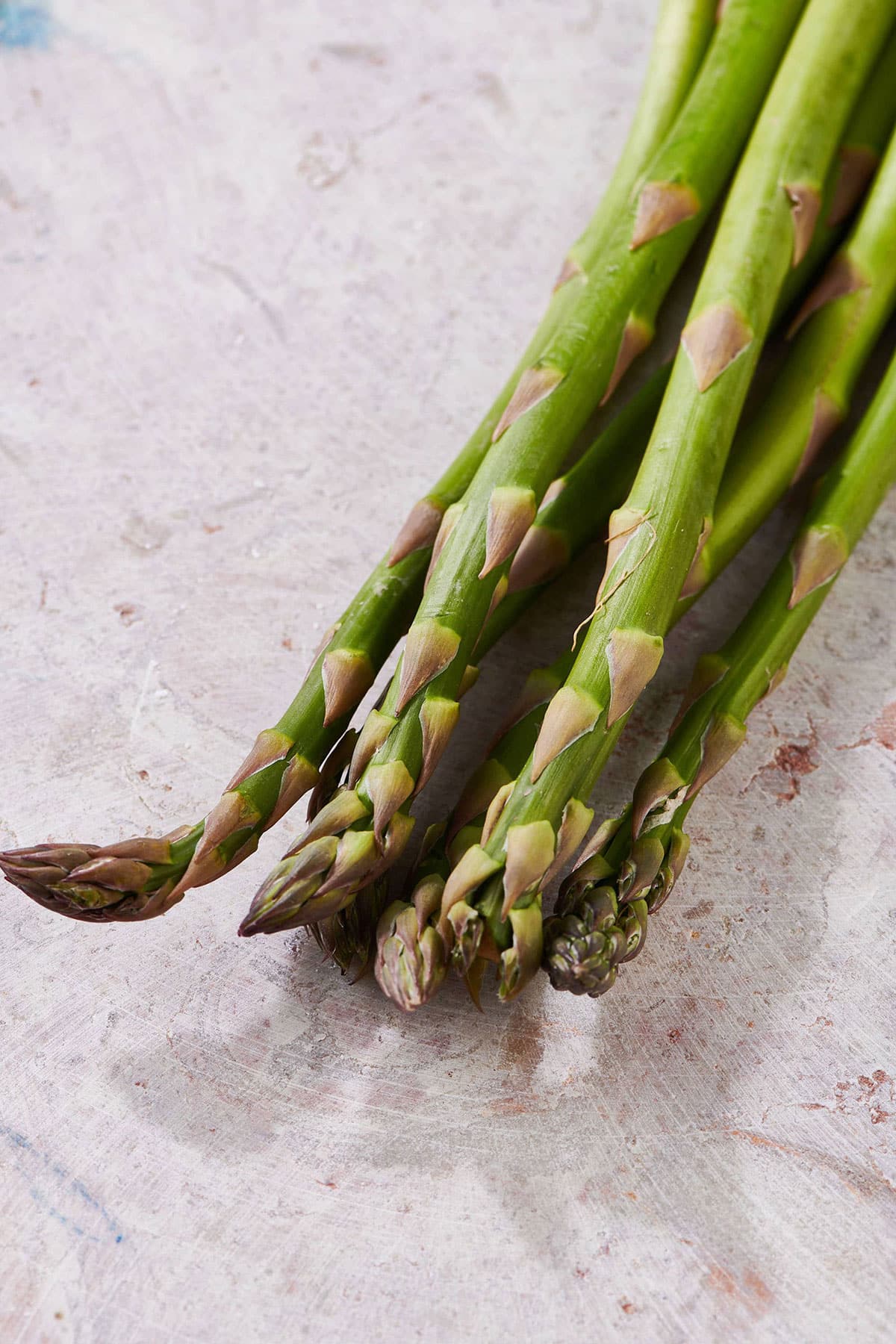
Blanching Asparagus Before Freezing
Boiling or steaming asparagus briefly before you freeze it locks in the texture and bright green color of the vegetable (this is true when freezing most vegetables). Blanching simply means quick-cooking a vegetable and then plunging it into an ice water bath to “shock” the vegetable, e.g., stop the cooking. This also helps the asparagus retain its color and texture. Just don’t blanch for too long, as overcooking will cause asparagus to become soggy.
How to Freeze Asparagus
- Prepare the ice bath: Fill a large bowl with ice water and set aside.
- Boil water: Heat an inch or so of salted water in a large pot.
- Cook the asparagus: Once the water has come to a boil, place the asparagus in the pot no more than a few layers deep (tongs are great for this), and cover the pot. Return the water to a simmer.

- Drain and blanch: When the asparagus spears are cooked to a crisp-tender stage, drain the asparagus. This should take about 2 minutes for thin spears and 4 minutes for thicker stalks. When you poke the spears with the tip of a sharp knife, you should feel slight resistance. The color should be bright green. Immediately plunge the asparagus into the bowl of ice water. Allow the asparagus to cool completely in the ice bath, then remove; you can use tongs or a slotted spoon for this.

- Dry the asparagus and prep it for freezing: Transfer the cooled asparagus to a clean dish towel and pat dry (you can also use paper towels). Transfer the asparagus to a freezer-proof bag, pressing out all the air. At this point, you can also cut the asparagus into pieces before freezing it if you know you are going to be using them in a casserole, a risotto, or a stir-fry and need smaller pieces. Label the bag, and freeze.
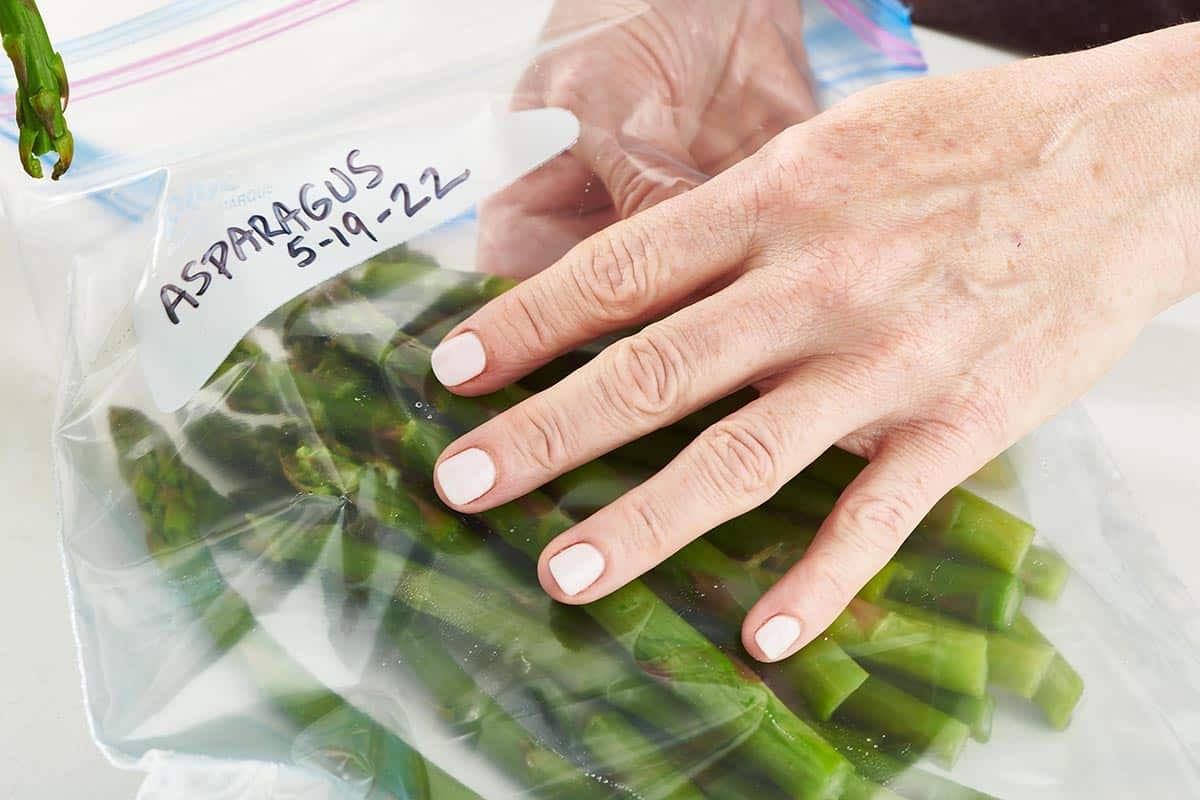
Defrosting Asparagus
You can either thaw the asparagus at room temperature for a few hours or in the fridge overnight. Or, if you are using the asparagus in a recipe that is going to be cooked or heated, you can use the asparagus straight from the freezer. The stalks will defrost quickly in whatever dish you are making.
Tips
- Make sure to use a large pot, preferably big enough for the asparagus to lie flat in or at least large enough for the asparagus to fit into the pot at an angle with the lid tightly placed on top.
- Make sure to have the ice bath ready before you put the asparagus in the boiling water, as the cooking time is very quick.
- If you have thick asparagus, you may want to not only trim off the bottom inch of the stem but also peel the tough outer skin on the bottom few inches of the stalk.
FAQs
See here for a chart on asparagus cooking time, depending on thickness. If you are planning to freeze the asparagus, you want to cook it on the shorter side, especially if the asparagus is going to be heated in another recipe after they’ve been taken from the freezer.
I do recommend the blanching step, but it is possible to freeze raw asparagus. If you freeze asparagus without blanching it first, you still need to prep it by removing the unwanted bottom parts and washing the stalks. Keep in mind that unblanched asparagus stalks will deteriorate more quickly in the freezer, losing some color, taste, and texture. Unblanched frozen asparagus is best used in things like soups where the difference in texture will be less noticeable. You don’t have to defrost it before adding it to soups or stews.
If you want to be able to use a few stalks of asparagus at a time without having to defrost the whole bunch, flash-freeze them before transferring them to a bag. Place the asparagus in a single layer on a plate, pan, or baking sheet and transfer it to the freezer. Once they are partially frozen, after about 30 minutes, transfer them to a freezer bag. Press out excess air and freeze completely. The asparagus will stay in separate stalks in the freezer.
You can store asparagus for up to 8 months in the freezer.
Asparagus Recipes to Try

Recipes With Asparagus
- Asparagus with Scallion Chimichurri Sauce
- Grilled Asparagus with Vinaigrette
- Asparagus with Herb Dipping Sauce
- Asparagus Remoulade with Egg
- Simple Roasted Asparagus with Shallots and Parmesan
Pin this now to find it later
Pin It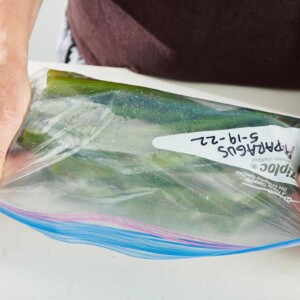
How to Freeze Asparagus
Ingredients
- Kosher salt (to taste)
- 1 pound asparagus (trimmed)
Instructions
- Fill a large bowl with ice water and set aside.
- Heat an inch or so of salted water in a large pot, preferably big enough for the asparagus to lie flat in. If your pot isn’t large enough to fit the asparagus in a horizontal layer, that’s ok, as long as there is enough room for the asparagus to fit into the pot with the lid tightly placed on top.
- Once the water has come to a boil, place the asparagus in the pot no more than a few layers deep, and cover the pot. Return the water to a simmer. When the asparagus is cooked to a crisp-tender stage, about 2 minutes for thin spears, and 4 minutes for thicker stalks, drain the asparagus and plunge into the ice bath. When you poke the spears with the tip of a sharp knife, you should feel slight resistance. The color should be bright green. Allow to cool completely in the ice bath.
- Drain the asparagus and transfer to a clean dish towel and pat dry. You can then either transfer the asparagus to a freezer-proof bag, press out all the air, label the bag, and freeze; or, if you want to be able to pull out a smaller amount of the stalks at a time, flash-freeze them before transferring to a bag. Place the asparagus in a single layer on a plate or baking sheet and transfer to the freezer. Once they are partially frozen, after about 30 minutes, transfer them to a freezer-proof bag, press out the air, and freeze completely. These will last for up to 8 months in the freezer.
Notes
- Cooking asparagus briefly before you freeze it locks in the texture and bright green color of the vegetable (this is true of freezing most vegetables). Blanching simply means quick-cooking a vegetable, and then plunging it into an ice water bath to “shock” the vegetable, e.g., stop the cooking. This also helps the asparagus (or other vegetable) retain its color and texture.
- Make sure to use a large pot, preferably big enough for the asparagus to lie flat in, or at least large enough for the asparagus to fit into the pot at an angle with the lid tightly placed on top.
- Make sure to have the ice bath ready before you put the asparagus in the boiling water, as the cooking time is very quick.
- If you have thick asparagus, you may want to not only trim off the bottom inch of the stem but also peel the tough outer skin on the bottom few inches of the stalk.
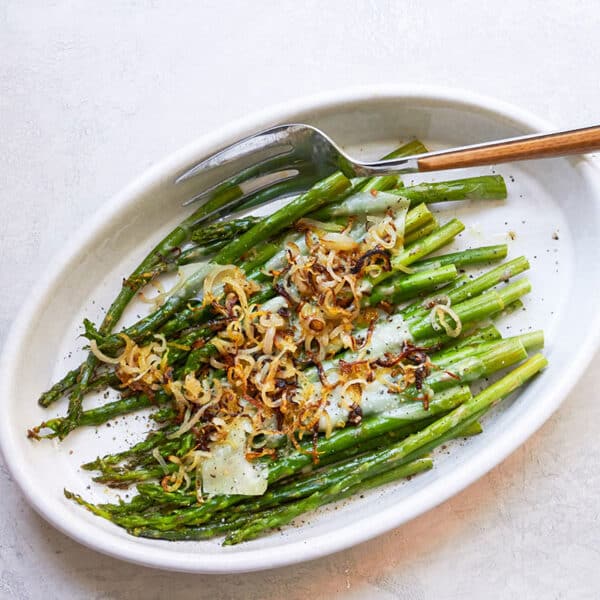
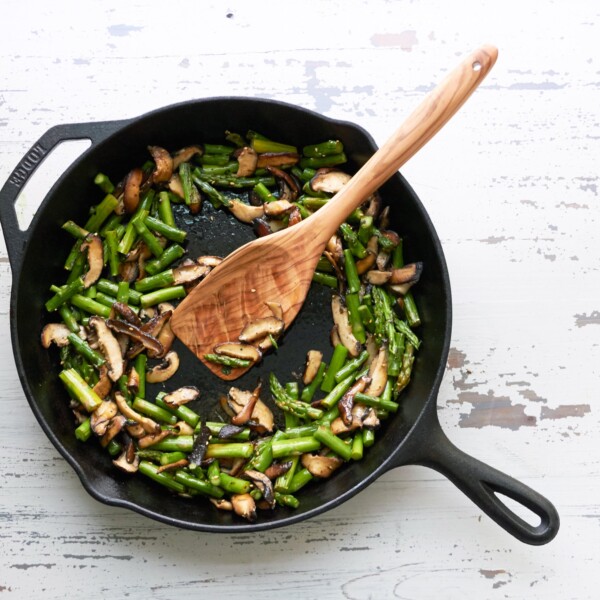
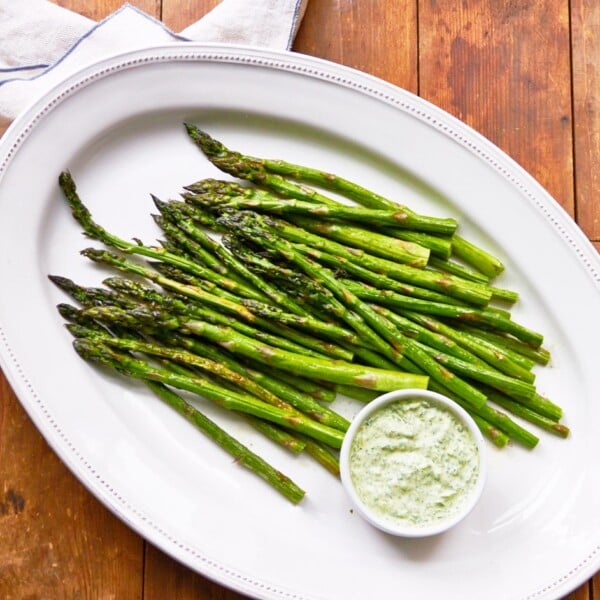
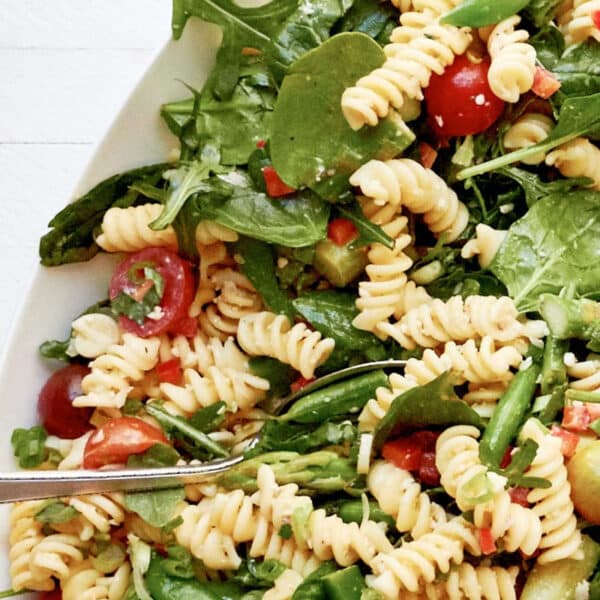
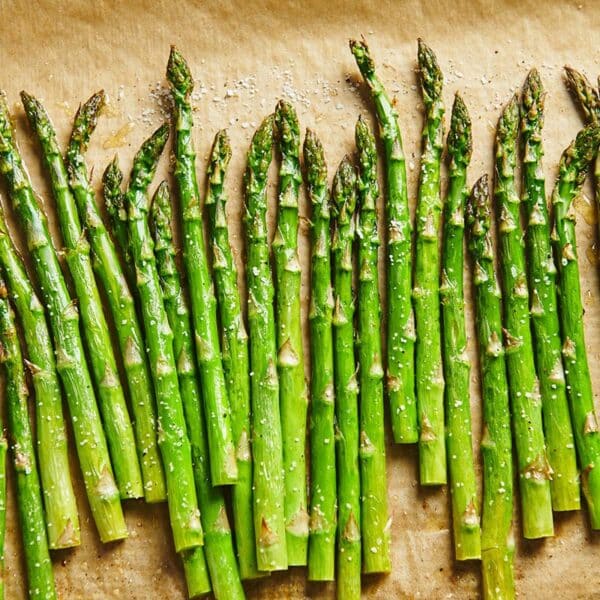
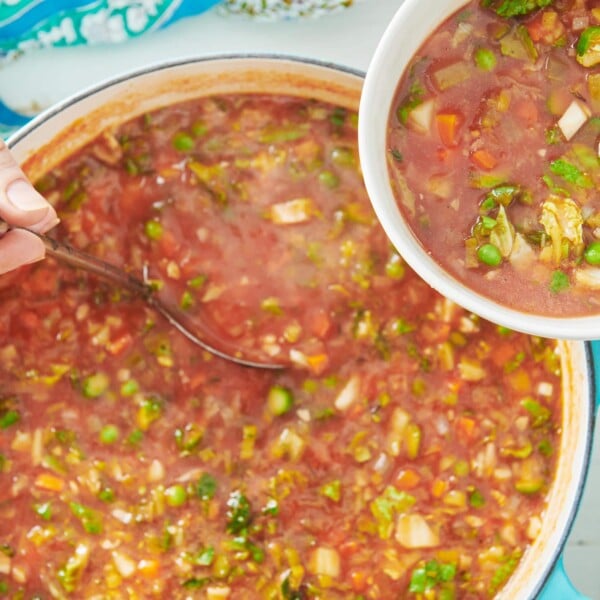
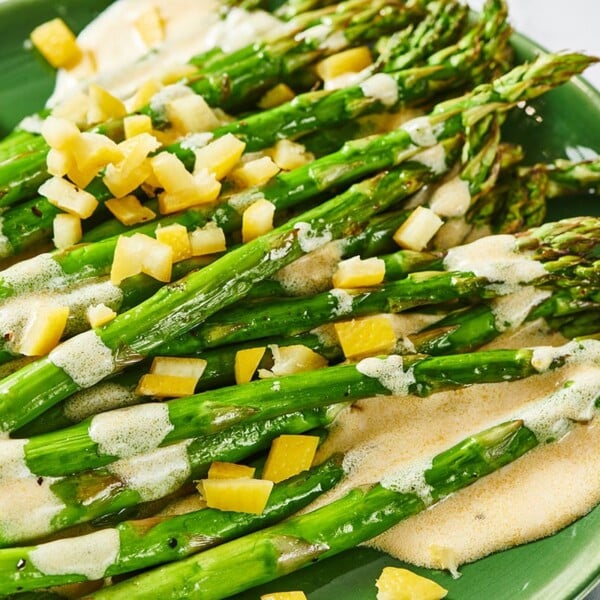









My favorite vegetable! Your recipe is a doable for me. Thanks for sharing your recipe.